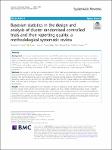Bayesian statistics in the design and analysis of cluster randomised controlled trials and their reporting quality: a methodological systematic review
| dc.contributor.author | Streeter, A | |
| dc.contributor.author | Baker, A | |
| dc.contributor.author | Moyeed, R | |
| dc.contributor.author | Creanor, S | |
| dc.date.accessioned | 2023-10-20T10:41:05Z | |
| dc.date.issued | 2021-03-31 | |
| dc.identifier.issn | 2046-4053 | |
| dc.identifier.issn | 2046-4053 | |
| dc.identifier.other | 91 | |
| dc.identifier.uri | https://pearl.plymouth.ac.uk/handle/10026.1/21473 | |
| dc.description.abstract |
Background In a cluster randomised controlled trial (CRCT), randomisation units are “clusters” such as schools or GP practices. This has methodological implications for study design and statistical analysis, since clustering often leads to correlation between observations which, if not accounted for, can lead to spurious conclusions of efficacy/effectiveness. Bayesian methodology offers a flexible, intuitive framework to deal with such issues, but its use within CRCT design and analysis appears limited. This review aims to explore and quantify the use of Bayesian methodology in the design and analysis of CRCTs, and appraise the quality of reporting against CONSORT guidelines. Methods We sought to identify all reported/published CRCTs that incorporated Bayesian methodology and papers reporting development of new Bayesian methodology in this context, without restriction on publication date or location. We searched Medline and Embase and the Cochrane Central Register of Controlled Trials (CENTRAL). Reporting quality metrics according to the CONSORT extension for CRCTs were collected, as well as demographic data, type and nature of Bayesian methodology used, journal endorsement of CONSORT guidelines, and statistician involvement. Results Twenty-seven publications were included, six from an additional hand search. Eleven (40.7%) were reports of CRCT results: seven (25.9%) were primary results papers and four (14.8%) reported secondary results. Thirteen papers (48.1%) reported Bayesian methodological developments, the remaining three (11.1%) compared different methods. Four (57.1%) of the primary results papers described the method of sample size calculation; none clearly accounted for clustering. Six (85.7%) clearly accounted for clustering in the analysis. All results papers reported use of Bayesian methods in the analysis but none in the design or sample size calculation. Conclusions The popularity of the CRCT design has increased rapidly in the last twenty years but this has not been mirrored by an uptake of Bayesian methodology in this context. Of studies using Bayesian methodology, there were some differences in reporting quality compared to CRCTs in general, but this study provided insufficient data to draw firm conclusions. There is an opportunity to further develop Bayesian methodology for the design and analysis of CRCTs in order to expand the accessibility, availability, and, ultimately, use of this approach. | |
| dc.format.extent | 91- | |
| dc.format.medium | Electronic | |
| dc.language | en | |
| dc.publisher | BioMed Central | |
| dc.subject | Cluster randomised trial | |
| dc.subject | Bayesian | |
| dc.subject | CONSORT statement | |
| dc.subject | Sample size | |
| dc.subject | Statistical power | |
| dc.subject | Hierarchical modelling | |
| dc.title | Bayesian statistics in the design and analysis of cluster randomised controlled trials and their reporting quality: a methodological systematic review | |
| dc.type | journal-article | |
| dc.type | Review | |
| plymouth.author-url | https://www.ncbi.nlm.nih.gov/pubmed/33789717 | |
| plymouth.issue | 1 | |
| plymouth.volume | 10 | |
| plymouth.publication-status | Published | |
| plymouth.journal | Systematic Reviews | |
| dc.identifier.doi | 10.1186/s13643-021-01637-1 | |
| plymouth.organisational-group | |Plymouth | |
| plymouth.organisational-group | |Plymouth|Research Groups | |
| plymouth.organisational-group | |Plymouth|Faculty of Health | |
| plymouth.organisational-group | |Plymouth|Research Groups|Institute of Health and Community | |
| plymouth.organisational-group | |Plymouth|Users by role | |
| plymouth.organisational-group | |Plymouth|Research Groups|Plymouth Institute of Health and Care Research (PIHR) | |
| dc.publisher.place | England | |
| dcterms.dateAccepted | 2021-03-11 | |
| dc.date.updated | 2023-10-20T10:41:05Z | |
| dc.rights.embargodate | 2023-10-21 | |
| dc.identifier.eissn | 2046-4053 | |
| rioxxterms.versionofrecord | 10.1186/s13643-021-01637-1 |


